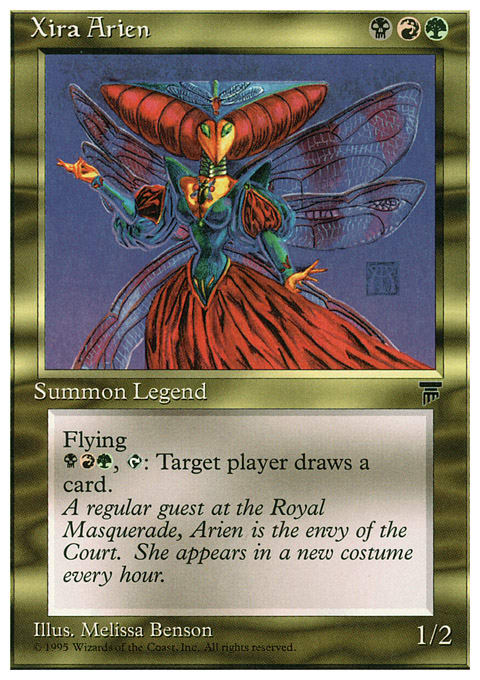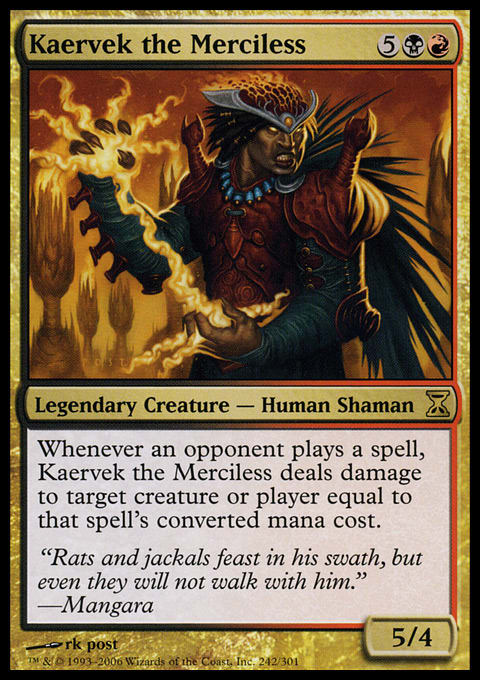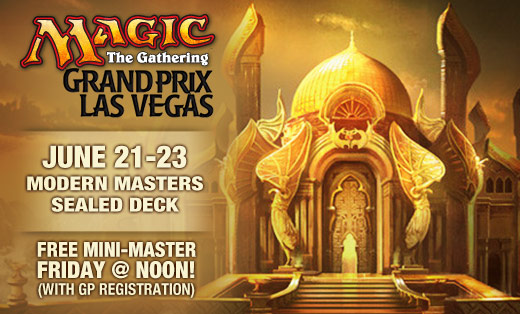Over the years, much ink has been spilled—well, many pixels have been temporarily blackened—about multiplayer threat assessment: how to spot The Threat, how to avoid looking like The Threat, and so on. Some decks exploit multiplayer better than others, but veteran groups generally have a good read on what’s dangerous.
And then there’s this deck I built a couple weeks ago. If your group hasn’t developed its understanding of threat assessment or ideas like the Metaclock, this deck will rack up free wins for a while. It doesn’t control the board; it isn’t group hug; it doesn’t threaten anyone for most of the game. Welcome to Commander with Xira Arien.
Firing up my Jund playlist1, here goes:
Saved by Xira
- Commander (0)
- Lands (50)
- 12 Forest
- 10 Swamp
- 8 Mountain
- 1 Golgari Guildgate
- 1 Gruul Guildgate
- 1 Rakdos Guildgate
- 1 Golgari Rot Farm
- 1 Gruul Turf
- 1 Rakdos Carnarium
- 1 Barren Moor
- 1 Forgotten Cave
- 1 Tranquil Thicket
- 1 Bant Panorama
- 1 Esper Panorama
- 1 Grixis Panorama
- 1 Jund Panorama
- 1 Naya Panorama
- 1 Terramorphic Expanse
- 1 Evolving Wilds
- 1 Transguild Promenade
- 1 Exotic Orchard
- 1 Darigaaz's Caldera
- 1 Bojuka Bog
- Turbo-Fog (17)
- 1 Bloodgift Demon
- 1 Charmbreaker Devils
- 1 Rites of Flourishing
- 1 Howling Mine
- 1 Jayemdae Tome
- 1 Spore Frog
- 1 Dawnstrider
- 1 Serene Sunset
- 1 Fog
- 1 Constant Mists
- 1 Fog Patch
- 1 Tangle
- 1 Moment's Peace
- 1 Terrifying Presence
- 1 Spore Cloud
- 1 Clinging Mists
- 1 Blunt the Assault
- Doing Things with Lands (14)
- 1 Ob Nixilis, the Fallen
- 1 Terravore
- 1 Worm Harvest
- 1 Countryside Crusher
- 1 Nantuko Cultivator
- 1 Borborygmos Enraged
- 1 Land's Edge
- 1 Seismic Assault
- 1 Seek the Horizon
- 1 Abundance
- 1 Scouting Trek
- 1 Ad Nauseam
- 1 Creeping Renaissance
- 1 Recollect
- Everything Else (18)
- 1 Fierce Empath
- 1 Madrush Cyclops
- 1 Sheoldred, Whispering One
- 1 Kaervek the Merciless
- 1 Lord of the Void
- 1 Sepulchral Primordial
- 1 Molten Primordial
- 1 Sylvan Primordial
- 1 Necrogenesis
- 1 Soul Conduit
- 1 Diabolic Tutor
- 1 Flesh // Blood
- 1 Savage Twister
- 1 Hex
- 1 Life's Finale
- 1 Destructive Force
- 1 Rakdos Charm
- 1 Crypt Incursion
So, how does this contraption assemble? It all starts with the commander.
Maximizing Xira with Turbo-Fog
Xira Arien does a couple things well. It looks unthreatening and is easily forgotten, especially relative to other Jund commanders. It also draws a card for mana. So, what does a full Xira deck want to do? It wants to look unthreatening, be easily forgotten, and draw cards on end steps. How do you accomplish all that in a threat-heavy format while still winning?
The best way I figured was to play oodles of Fog effects. This deck has twelve premier Fogs, from Moment's Peace to Tangle to Spore Cloud to Dawnstrider. Xira Arien and Dawnstrider create a strange pseudo-soft lock in which ![]()
![]()
![]()
![]() lets you have a Fog every turn cycle for no extra effort. Opponents’ awareness of your twelve Fogs is a rattlesnake they are generally unprepared ready for; it’s so important to this deck that you almost always want to leave
lets you have a Fog every turn cycle for no extra effort. Opponents’ awareness of your twelve Fogs is a rattlesnake they are generally unprepared ready for; it’s so important to this deck that you almost always want to leave ![]()
![]() open, much like a control player leaves
open, much like a control player leaves ![]()
![]() open for Counterspell. If you’re an opponent looking to risk vulnerability for a turn by alpha-striking somebody, do you want to swing at someone against whom it will matter or at Mr. Tangle/Spore Cloud? Sure, if everyone agrees to swing at you over a turn cycle, you’re probably dead, but that takes a level of cooperation rare in multiplayer. So, opponents tend to swing at each other and leave you alone.
open for Counterspell. If you’re an opponent looking to risk vulnerability for a turn by alpha-striking somebody, do you want to swing at someone against whom it will matter or at Mr. Tangle/Spore Cloud? Sure, if everyone agrees to swing at you over a turn cycle, you’re probably dead, but that takes a level of cooperation rare in multiplayer. So, opponents tend to swing at each other and leave you alone.
And if they leave you alone, you’re probably leaving them alone. Amusingly, apart from Rites of Flourishing and Sylvan Primordial, this deck can’t ramp. While everyone’s getting off to explosive starts, you’re playing a land and passing the turn. This deck is as Metaclock-friendly as it comes; there is no reason to look at your board or suspect you can do anything other than Fog and draw cards, and it’s basically true.
Of course, that plan doesn’t win games. So, how do you advance a game plan? By . . .
Doing Things with Lands
The deck is half lands, including thirty basic lands and ten lands that either cycle or sacrifice to find other lands. Besides ensuring an on-time-or-close Xira Arien, which is crucial to the deck running, the overstock of lands serves two primary purposes: fueling Borborygmos Enraged and friends and fueling Worm Harvest and friends.
Usually, building around Borborygmos Enraged involves him as your commander and with more lands than “just” fifty; see, e.g., my man Bennie Smith's take on it. But it’s not as though B.E. is the only effect of its ilk. Seismic Assault’s been around for a while; Land's Edge has been around longer, and it has other oddities, such as letting anyone discard anything for free. (The cards in this deck that care about opposing graveyards—Bojuka Bog, Sepulchral Primordial, Necrogenesis, Rakdos Charm, Crypt Incursion, and Flesh // Blood—are in part because of utility and in part because Land's Edge makes them necessary.)
Just as importantly, Borborygmos Enraged as a commander takes away the chance to work in black, whereas black lets us run Ad Nauseam and Scouting Trek on the one hand and Worm Harvest on the other. A Scouting Trek for your remaining basic lands will normally be for around twenty lands. Draw them all with Ad Nauseam, and the fun starts. (Ad Nauseam also can draw past those lands in an attempt to find combo pieces; Crypt Incursion helps give enough life for that task.) The ideal setup is Borborygmos Enraged, Scouting Trek, Ad Nauseam, Discard all your lands, Creeping Renaissance naming land, Rinsing, and Repeating.
The ideal is rarely achieved, but it’s also not always necessary due to opponents attacking each other most of the game. In the first four-player game I played with this deck, I wasn’t attacked until the final few turns since I had Xira Arien and Dawnstrider through the first half. By the time Borborygmos showed up, I was at 46 life, and my opponents combined for less than that, so I didn’t have to do much work to kill them. I killed the Elesh Norn, Grand Cenobite player, who was at 9 life, by pitching two lands for 6 damage and swinging with a 3/2 intimidating Sepulchral Primordial (due to Elesh Norn).
Worm Harvest and Terravore are backups for when you’ve been cycling and discarding lands but haven’t found the main combo, with Madrush Cyclops’s haste making the backups harder to deal with. If you’ve been holding Worm Harvest and a land in your hand for a while, it isn’t hard in the late game to have 10 mana and seven to ten lands in your graveyard, at which point Madrush Cyclops gives you fourteen to twenty surprise Worms of death.
Many of you might wonder why Life from the Loam isn’t here. I didn’t see a point—partly for price, but mainly because it doesn’t help the combo go off. Life from the Loam would do much more if I could rely on Borborygmos Enraged’s 3 damage as my discard outlet, but I often have to use the 2 damage from Land's Edge or Seismic Assault, making Life from the Loam more Lava Axe and less Searing Wind. I also don’t want to dredge; I have few ways to recur nonland combo pieces, and by the time the combo’s ready, Xira Arien’s 7 or 9 mana from the command zone, at which point casting it and tapping ![]()
![]()
![]() just to dredge Life from the Loam is too slow.
just to dredge Life from the Loam is too slow.
The Rest
There’s not room for much else, so what’s there needs to be high-impact. Three Primordials, Lord of the Void, and Sheoldred qualify. Kaervek the Merciless is even better in this deck than in most other places. You don’t want to drop him indiscriminately, but given how often opponents attack each other, there’s a spot in the game at which Kaervek nearly locks a player or two out of spells. Kaervek’s damage takes pressure off the combo plan, as does Ob Nixilis, the Fallen, who works as well as Borborygmos Enraged when the game’s down to two players.
Charmbreaker Devils is at its best here when recurring Fogs; that is not a half-sentence I ever expected to type. Fierce Empath, Diabolic Tutor, Savage Twister, Hex, and Life's Finale do what they say on the tin. I’ve been disappointed with Hex in many Commander decks, but as this deck is more about Fogs than board wipes, there are usually six creatures available to kill with Hex, making it work better here than other places. Few decks are prepared for Destructive Force; in this deck, not only do you want to put five more lands in your graveyard, being a deck that’s half lands means you’ll recover faster than anyone else. Besides, in a four-player game, Destructive Force gives Terravore +20/+20, which is a combo Timmy, Spike, and possibly Johnny can get behind. Fun for the whole psychographic family!
A final note deserves to go to Soul Conduit. My first game with this deck was a duel against a fairly high-powered Maelstrom Wanderer deck (I’m not sure there’s another type). I played Soul Conduit as soon as possible, cast Fog effects occasionally, and let myself fall down to 2. I switched life totals with Soul Conduit with mana for a Fog effect and then cast Ob Nixilis and played a land for lethal life-loss. The Maelstrom Wanderer deck’s main interactions were combat damage, so there wasn’t a whole lot my opponent could do about it; he had to attack and hope it worked. But Soul Conduit said “no,” as it can do to anyone who thinks attacking you through your Fogs is a good idea.
Conclusion
If you’ve ever wanted to show someone how multiplayer has different considerations than duels, this is the deck to prove it. By any power level assessment, Xira Arien is never the right commander; Karrthus, Tyrant of Jund, Kresh the Bloodbraided, and Sek'Kuar, Deathkeeper are at the counter while Xira’s taking a number and waiting in line. But frequent Fogs change a Commander game in a way counterspells never have. You have to try casting spells; you don’t have to swing at Mr. Fog. I’ve never played or faced anything like this deck, especially in Commander. I highly recommend this deck if you like multiplayer theory and/or want a change of pace. Given my readership, both probably apply to you.
1 I have hour-long playlists for every color combination from zero to three colors based on color pie philosophy and how those ideas are expressed in music. My Jund playlist is:
- “Oakum” by Ozric Tentacles
- “Snakefood” by Safri Duo
- “Conga Fury” by Juno Reactor
- “Bridge” by Amon Tobin
- “Afroclonk” by Ozric Tentacles
- “Salt” by Hybrid
- “Lisboa” by the Durutti Column
- “The Price of Everything and the Value of Nothing” by Animals as Leaders
- “My Kingdom (Part 1)” by the Future Sound of London

























